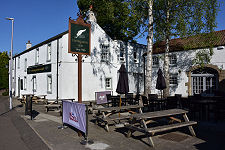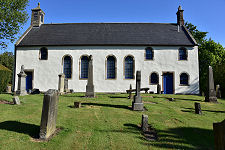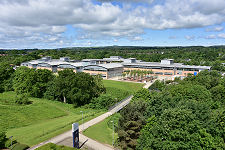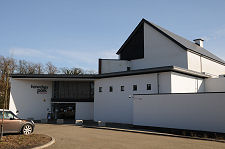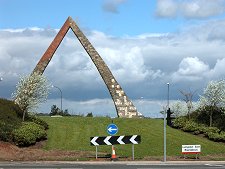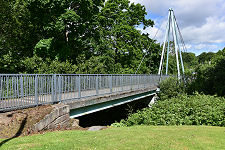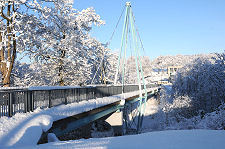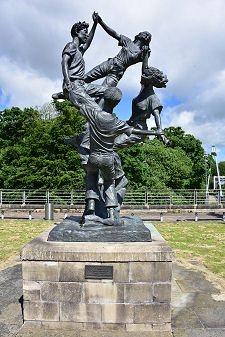 Livingston Town Centre |
Livingston is the second biggest settlement in the Lothians after Edinburgh, the seventh biggest in Scotland, and has a population larger than Perth, Stirling or Inverness. Not bad for somewhere that until 1962 was open farmland surrounding a fairly ancient village on the road from Edinburgh to Glasgow.
After over six decades of spectacular growth, what was once "Livingston New Town" has long been known just as Livingston. Livingston was the fourth of the Scottish new towns created to help accommodate overspill from Glasgow's densely populated areas in the years following the Second World War, and by many measures it has been the most successful of them. Today's Livingston covers some ten square miles of the River Almond valley to the south of the line of the M8 motorway, and has a population that in 2022 stood at 55,836.
The key factor in Livingston's success has been its location. Lying just 15 miles west of Edinburgh, it has benefitted from the capital's spectacular economic success. The result has been a boom in house building accompanied by high levels of investment in shopping and other services in the town. And while the downturn in the worldwide electronics industry did take the gloss off its reputation as the "Capital of Silicon Glen", wider growth has continued. (Continues below images...)
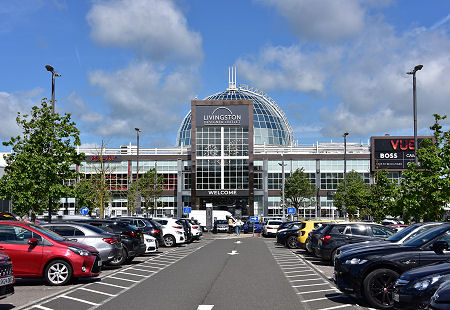 Livingston Designer Outlet |
 The Stones of Livingston |
At the heart of the town is its shopping centre. Other developments include the West Lothian College. This lies close to the slightly longer established St Margaret's Academy, built in 1994.
And between the college and the academy is the home of a more famous incomer. In 1995 the Edinburgh football club Meadowbank Thistle renamed itself Livingston and subsequently moved to a new ground at Almondvale. Its progress though the Scottish leagues since then has been spectacular both for its climbs and for its descents. The most recent new arrival in the town is the attractive building which serves as a headquarters for West Lothian Council and as a police station and courthouse. This was built in what was previously open parkland on the north side of the River Almond close to the town centre. Also in Livingston is the Almond Valley Heritage Centre.
Livingston has been unflatteringly called "roundabout city" and there's certainly no shortage of them. Like anywhere else, it's quite easy to find you way around the town when you know it: but to aid first time visitors and enhance the overall look of the place, five of the most important roundabouts have been given monumental sculptures. See the same one twice and you have indeed been going round in circles.
Not all of Livingston has simply sprung out of the fields since 1962. The name was taken from the existing Livingston Village, one of a number of old settlements which add character to their newer neighbours. Livingston actually dates back to the 1100s when a Flemish entrepreneur called De Leving was granted land in the area. He built a fortified tower The Peel of Leving's-toun, now long gone, and the settlement that grew up around it became known as Levingstoun and, in time, Livingston. The Peel was replaced by nearby Livingston House, which was demolished in the 1840s.
At the core of Livingston village is the Old Parish Kirk, built in 1732 to replace an earlier chapel dating back to 1150 but destroyed by Cromwell's troops in 1650. Nearby is the Livingston Inn, also dating back to the 1700s. This was built as a coaching inn on the main Edinburgh to Glasgow route, one of a number providing fresh horses for the coaches and refreshments for the passengers. By 1780 these enabled the "Edinburgh to Glasgow Flyer" to complete the 50 mile journey between the two cities in a little over 24 hours! Not far from Livingston Village is a not-so ancient monument known as the Stones of Livingston.
Another of the town's older buildings has returned from the brink of dereliction in recent years. Howden House has been restored to residential use, which is particularly important as it dominates the approach to the excellent Howden Park Centre.
Livingston has also lent its name to the Livingston Incident, an alleged encounter with a UFO which took place on 9 November 1979 and which became the subject of a criminal investigation by the police.
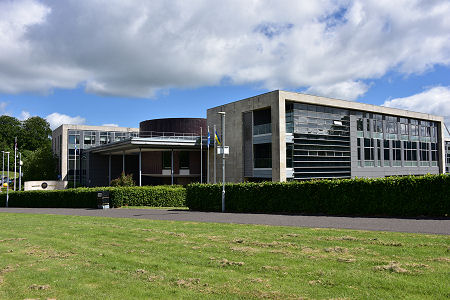 Livingston Civic Centre |

|
|
|
Visitor InformationView Location on MapWhat3Words Location: ///bliss.also.paper |
Livingston In Fiction
|
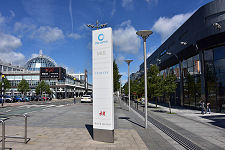 The Centre |
 Inside the Centre |
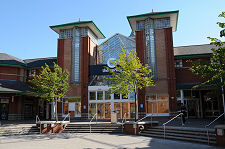 Earlier Phase of the Centre |
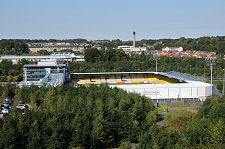 Livingston Football Club |
 Site of Livingston Peel |
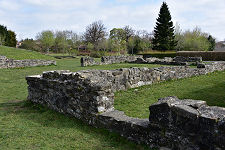 Site of Livingston House |
 War Memorial |
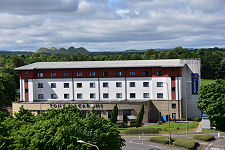 Travelodge and Five Sisters Bing |
 Outdoor Dining Areas |
 The High Road by Ken Lussey (15 September 2023).
The High Road by Ken Lussey (15 September 2023).